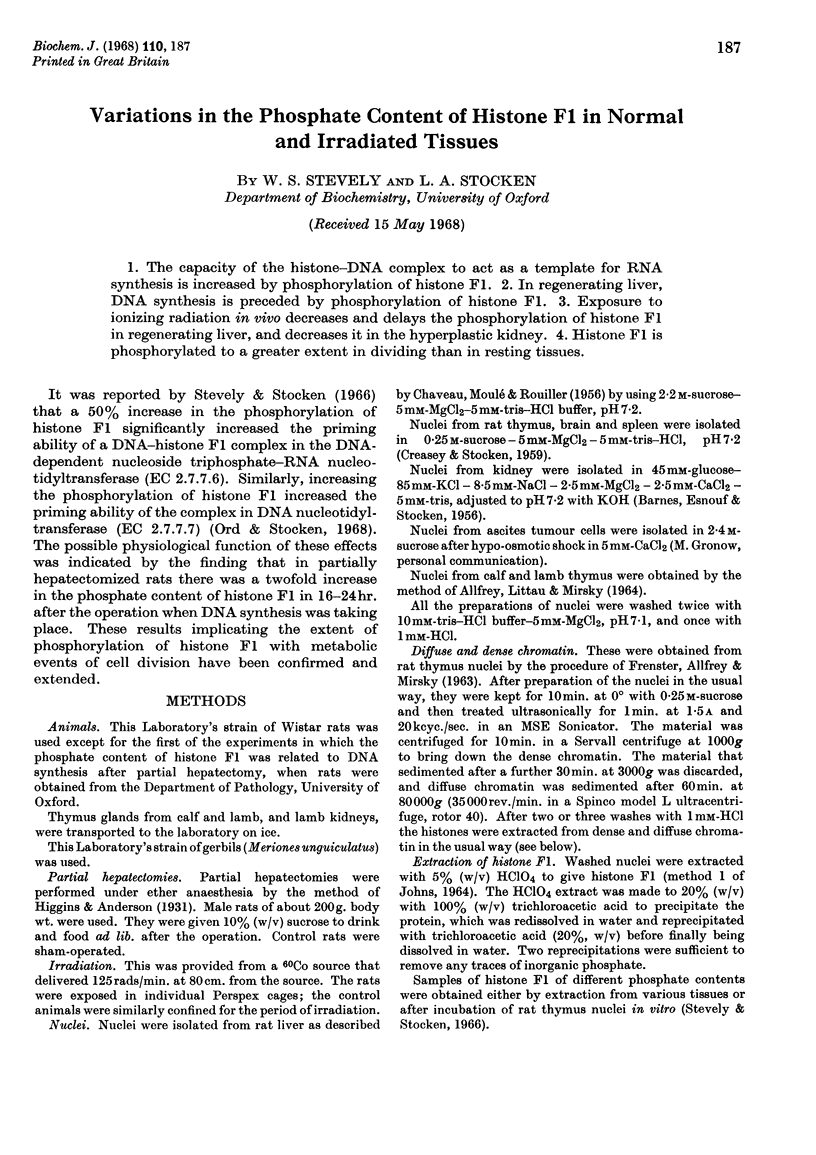Abstract
1. The capacity of the histone–DNA complex to act as a template for RNA synthesis is increased by phosphorylation of histone F1. 2. In regenerating liver, DNA synthesis is preceded by phosphorylation of histone F1. 3. Exposure to ionizing radiation in vivo decreases and delays the phosphorylation of histone F1 in regenerating liver, and decreases it in the hyperplastic kidney. 4. Histone F1 is phosphorylated to a greater extent in dividing than in resting tissues.
Full text
PDF




Selected References
These references are in PubMed. This may not be the complete list of references from this article.
- ALLFREY V. G., LITTAU V. C., MIRSKY A. E. METHODS FOR THE PURIFICATION OF THYMUS NUCLEI AND THEIR APPLICATION TO STUDIES OF NUCLEAR PROTEIN SYNTHESIS. J Cell Biol. 1964 May;21:213–231. doi: 10.1083/jcb.21.2.213. [DOI] [PMC free article] [PubMed] [Google Scholar]
- BARTLETT G. R. Phosphorus assay in column chromatography. J Biol Chem. 1959 Mar;234(3):466–468. [PubMed] [Google Scholar]
- Butler J. A., Chipperfield A. R. Inhibition of RNA polymerase by histones. Nature. 1967 Sep 9;215(5106):1188–1189. doi: 10.1038/2151188a0. [DOI] [PubMed] [Google Scholar]
- CHAUVEAU J., MOULE Y., ROUILLER C. Isolation of pure and unaltered liver nuclei morphology and biochemical composition. Exp Cell Res. 1956 Aug;11(2):317–321. doi: 10.1016/0014-4827(56)90107-0. [DOI] [PubMed] [Google Scholar]
- CREASEY W. A., STOCKEN L. A. The effect of ionizing radiation on nuclear phosphorylation in the radio-sensitive tissues of the rat. Biochem J. 1959 Jul;72:519–523. doi: 10.1042/bj0720519. [DOI] [PMC free article] [PubMed] [Google Scholar]
- DELUCA H. A., ROSSITER R. J., STRICKLAND K. P. Incorporation of radioactive phosphate into the nucleic acids of brain slices. Biochem J. 1953 Sep;55(2):193–200. doi: 10.1042/bj0550193. [DOI] [PMC free article] [PubMed] [Google Scholar]
- FRENSTER J. H., ALLFREY V. G., MIRSKY A. E. REPRESSED AND ACTIVE CHROMATIN ISOLATED FROM INTERPHASE LYMPHOCYTES. Proc Natl Acad Sci U S A. 1963 Dec;50:1026–1032. doi: 10.1073/pnas.50.6.1026. [DOI] [PMC free article] [PubMed] [Google Scholar]
- Johns E. W. Studies on histones. 7. Preparative methods for histone fractions from calf thymus. Biochem J. 1964 Jul;92(1):55–59. doi: 10.1042/bj0920055. [DOI] [PMC free article] [PubMed] [Google Scholar]
- LOWRY O. H., ROSEBROUGH N. J., FARR A. L., RANDALL R. J. Protein measurement with the Folin phenol reagent. J Biol Chem. 1951 Nov;193(1):265–275. [PubMed] [Google Scholar]
- Mano Y., Lipmann F. Characteristics of phosphoproteins (phosvitins) from a varitey of fish roes. J Biol Chem. 1966 Aug 25;241(16):3822–3833. [PubMed] [Google Scholar]
- Ord M. G., Stocken L. A. Variations in the phosphate content and thiołdisulphide ratio of histones during the cell cycle. Studies with regenerating rat liver and sea urchins. Biochem J. 1968 Apr;107(3):403–410. doi: 10.1042/bj1070403. [DOI] [PMC free article] [PubMed] [Google Scholar]
- Wachtel L. W., Phillips T. L., Cole L. J. Systemic factor in recovery of rat kidney from x-irradiation: thymidine-H3 incorporation studies. Radiat Res. 1966 Jul;28(3):647–656. [PubMed] [Google Scholar]


